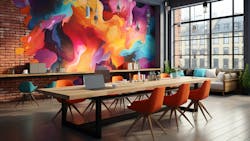ASID’s 2024 Top Trends Impacting Interior Design
The year is off and running and designers, as always, are thinking ahead on how to improve the impact of their work and the lives of the occupants who inhabit it. The American Society of Interior Designers (ASID) annually publishes the Trends Outlook Report, created by ASID’s research division, which serves as a guidepost for interior designers. The report looks at global, economic and societal trends and identifies their implications on the design profession. Let’s detail these key trends a bit, which span all sectors of interior design.
You can read more free here, or download the full 2024 Trends Outlook Report at www.asid.org.
1. Living with and Learning from Gen Z:
Gen Z seeks genuine connections, and as this generation enters and occupies consumer culture, designers should be familiar with their evolving empathies and concerns.
2. Solo Living and Seeking Connection:
With solo living on the rise, Americans are seeking connectedness to loved ones and their communities.
3. Comfortable and Connected Living:
Designers can support the comfort and camaraderie occupants desire by creating opportunities for gathering in the home, incorporating pet-friendly products, and designing spaces for amusement and "eatertainment."
4. Health & Wellness:
Consumers will spend more on the products that improve their health and wellbeing. Designers must consider this self-care push, including harnessing sleep data to support more rest for occupants.
5. Quiet Luxury:
Consumers seek a more low-key and personalized approach to luxury, investing in items that have more longevity and relevance, which is a more sustainable way to shop as well.
6. Blurred Lines in Travel:
Alternative accommodations are on the rise, with guests blurring the lines of living, working, staying and playing.
7. A Custom Approach to Today's Workplace:
Designers have the opportunity to help organizations create a more personalized approach to their hybrid work strategies, with physical spaces that support employee productivity and balance collaboration with focus.
8. AI Technology:
Generative AI applications are being used in a variety of applications, such as generating floor plans, design iterations, occupancy and energy models, among other solutions; others are using it to increase autonomy and create experience-driven design.
9. Digital Marketing in Design:
Employers, including designers, can look to their own workforce for advertising, as many employees are communicating and advocating for their brands on social media.
10. Extreme Weather Events and Climate Impact:
Two-thirds of Americans say that they've experienced at least one of the five types of extreme weather (heat wave, flood, drought, wildfire, rising sea level), in the past year. Americans support making changes to address global climate change and prioritizing renewable sources— and designers have the power to contribute to these solutions.
11. Sustainability Rules:
Designers who can help clients meet their sustainability targets of high-quality, low-carbon workspaces will have a competitive advantage. Recognizing the interconnectedness of individual health, community health, and environmental stewardship also pays a key role.
